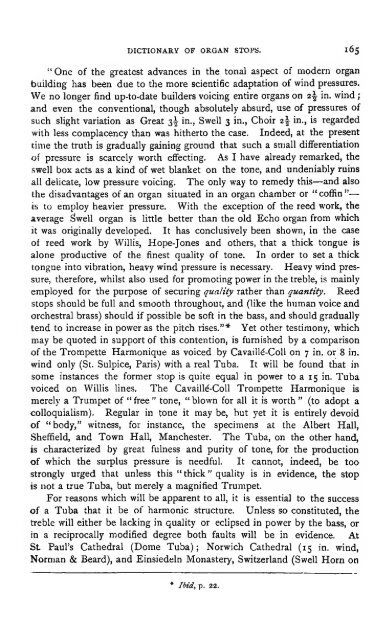A comprehensive dictionary of organ stops - Allen Organ Studio of ...
A comprehensive dictionary of organ stops - Allen Organ Studio of ...
A comprehensive dictionary of organ stops - Allen Organ Studio of ...
You also want an ePaper? Increase the reach of your titles
YUMPU automatically turns print PDFs into web optimized ePapers that Google loves.
DICTIONARY OF ORGAN STOPS. 165<br />
" One <strong>of</strong> the greatest advances in the tonal aspect <strong>of</strong> modern <strong>organ</strong><br />
building has been due to the more scientific adaptation <strong>of</strong> wind pressures.<br />
We no longer find up-to-date builders voicing entire <strong>organ</strong>s on 2$< in. wind<br />
and even the conventional, though absolutely absurd, use <strong>of</strong> pressures <strong>of</strong><br />
such slight variation as Great 3^ in., Swell 3 in., Choir z\ in., is regarded<br />
with less complacency than was hitherto the case. Indeed, at the present<br />
time the truth is gradually gaining ground that such a small differentiation<br />
<strong>of</strong> pressure is scarcely worth effecting. As I have already remarked, the<br />
swell box acts as a kind <strong>of</strong> wet blanket on the tone, and undeniably ruins<br />
all delicate, low pressure voicing. The only way to remedy this—and also<br />
the disadvantages <strong>of</strong> an <strong>organ</strong> situated in an <strong>organ</strong> chamber or "c<strong>of</strong>fin"<br />
is to employ heavier pressure. With the exception <strong>of</strong> the reed work, the<br />
average Swell <strong>organ</strong> is little better than the old Echo <strong>organ</strong> from which<br />
it was originally developed. It has conclusively been shown, in the case<br />
<strong>of</strong> reed work by Willis, Hope-Jones and others, that a thick tongue is<br />
alone productive <strong>of</strong> the finest quality <strong>of</strong> tone. In order to set a thick<br />
tongue into vibration, heavy wind pressure is necessary. Heavy wind pres-<br />
sure, therefore, whilst also used for promoting power in the treble, is mainly<br />
employed for the purpose <strong>of</strong> securing quality rather than quantity. Reed<br />
<strong>stops</strong> should be full and smooth throughout, and (like the human voice and<br />
orchestral brass) should if possible be s<strong>of</strong>t in the bass, and should gradually<br />
tend to increase in power as the pitch rises."* Yet other testimony, which<br />
may be quoted in support <strong>of</strong> this contention, is furnished by a comparison<br />
<strong>of</strong> the Trompette Harmonique as voiced by Cavaille-Coll on 7 in. or 8 in.<br />
wind only (St. Sulpice, Paris) with a real Tuba. It will be found that in<br />
some instances the former stop is quite equal in power to a 15 in. Tuba<br />
voiced on Willis lines. The Cavaille'-Coll Trompette Harmonique is<br />
merely a Trumpet <strong>of</strong> " free " tone, " blown for all it is worth " (to adopt a<br />
colloquialism). Regular in tone it may be, but yet it is entirely devoid<br />
<strong>of</strong> " body," witness, for instance, the specimens at the Albert Hall,<br />
Sheffield, and Town Hall, Manchester. The Tuba, on the other hand,<br />
is characterized by great fulness and purity <strong>of</strong> tone, for the production<br />
<strong>of</strong> which the surplus pressure is needful. It cannot, indeed, be too<br />
strongly urged that unless this " thick " quality is in evidence, the stop<br />
is not a true Tuba, but merely a magnified Trumpet.<br />
For reasons which will be apparent to all, it is essential to the success<br />
<strong>of</strong> a Tuba that it be <strong>of</strong> harmonic structure. Unless so constituted, the<br />
treble will either be lacking in quality or eclipsed in power by the bass, or<br />
in a reciprocally modified degree both faults will be in evidence. At<br />
St Paul's Cathedral (Dome Tuba); Norwich Cathedral (15 in. wind,<br />
Norman & Beard), and Einsiedeln Monastery, Switzerland (Swell Horn on<br />
* Ibid, p. 22.<br />
— ;


